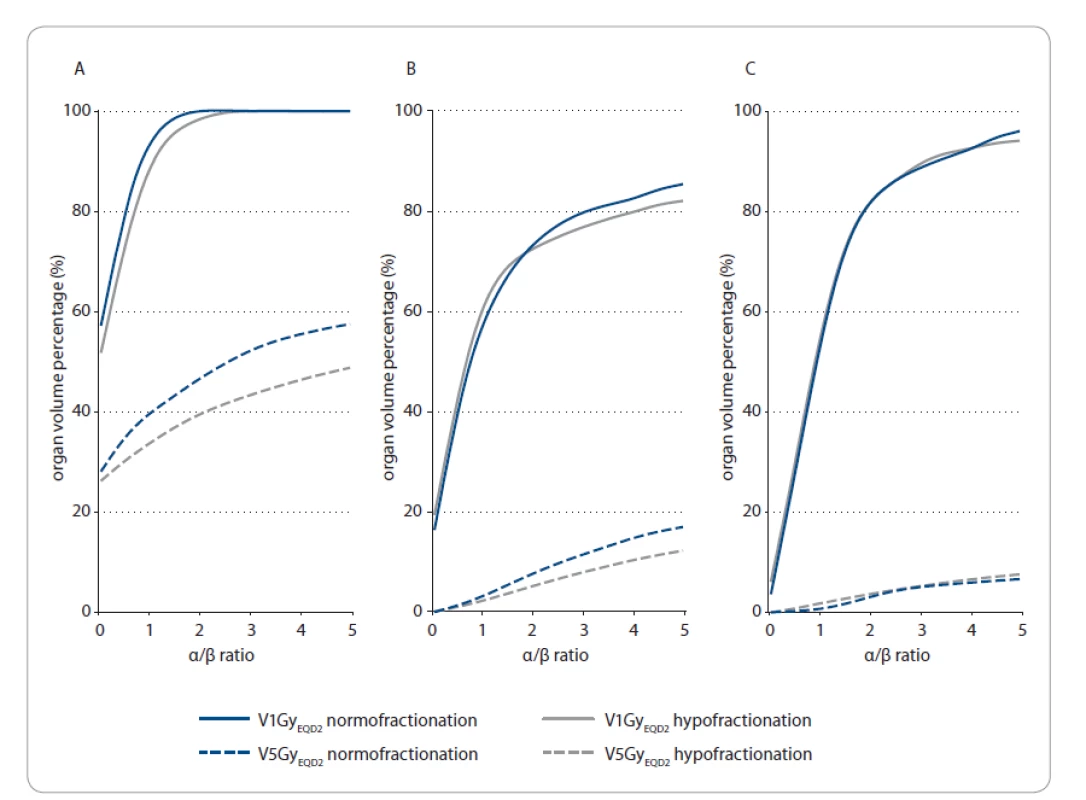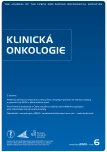Low dose exposure evaluation for hypofractionated breast intensity modulated radiation therapy – taking into account the fraction-size effect with the linear quadratic model
Authors:
Pierre Loap; Youlia Kirova
Authors‘ workplace:
Institut Curie, Paris, France
Published in:
Klin Onkol 2020; 33(6): 474-476
Category:
Introduction
Adjuvant radiation therapy after breast conserving surgery improves local control and reduces cancer mortality [1]. However, first generation breast irradiation techniques, based on wide irradiation fields, were associated with an increased cardiac mortality [2]. Fortunately, radiation therapy techniques evolved and current state-of-the-art breast irradiation techniques, such as rotational intensity modulated radiation therapy (rIMRT), improve cardiac sparing for breast cancer irradiation [3]while homogeneously covering target volumes for complex anatomic cases (such as pectus excavatum or breast implants). However, these recent techniques are associated with a greater low-dose radiation exposure to the lungs when compared with standard tridimensional techniques [4], which may lead to greater pulmonary toxicity such as fibrosis [5]. Hypofractionation for breast rIMRT is currently being evaluated [6] and since hypofractionation lowers total radiation dose, low-dose radiation exposure to the lung may be reduced accordingly. However, the fraction-size effect has to be taken into account when comparing hypofractionated regimens. In this perspective, we compared low-dose radiation exposure to the lungs and to the contralateral breast between hypofractionated and normofractionated breast rIMRT, taking into account the fraction-size effect with the linear-quadratic (LQ) model.
Methods
Thirty patients treated with adjuvant rIMRT were selected by stratified random sampling from our institutional database; 15 of them received hypofractionated irradiations and the 15 others received normofractionated irradiations. There were eight left-sided cancer patients in both fractionation groups. Volumes included the whole breast with a boost, homolateral axillary and internal mammary lymph nodes. A prescribed dose to the tumor bed was 63–66 Gy for normofractionated regimens and 52.2–56 Gy for hypofractionated regimens.
The dose-volume histograms (DVH) were retrieved for the lungs and for the contralateral breast. DVH doses were transformed into equivalent doses for 2 Gy fraction (EQD2) using the LQ model for α/β values ranging between 0 and 5 Gy (to take account of the uncertainty of this parameter).
EQD2 = n × d × (d + α/β) / (2 + α/β)
For each fractionation group, the median organ volume percentages receiving more than 1 Gy EQD2 (V1GyEQD2) and more than 5 Gy EQD2 (V5GyEQD2) were determined as functions of the a/b value.
Results
Fig. 1 provides V5GyEQD2 and V1GyEQD2 for the lungs and for the contralateral breast as functions of the α/β value, for each fractionation group. The lung V5GyEQD2 were lower in the hypofractionated group, independently of the α/β value. For α/β = 3 Gy, the homolateral lung V5GyEQD2 was 43.0% with hypofractionation vs. 51.7% with normofractionation; the contralateral lung V5GyEQD2 was 7.6% with hypofractionation vs. 11.1% with normofractionation. This dosimetric benefit of hypofractionation was more modest for the lung V1GyEQD2. For α/β = 3 Gy, the homolateral lung V1GyEQD2 was 100% for both groups, while the contralateral lung V1GyEQD2 was 76.6% with hypofractionation vs. 79.5% with normofractionation. Lastly, V5GyEQD2 and V1GyEQD2 for the contralateral breast were similar between the two fractionation groups.

Discussion
Taking into account the fraction-size radiobiological effect, this analysis confirmed that hypofractionated rIMRT reduced fraction-size corrected low-dose exposure to the lungs. Nevertheless, no substantial benefit was found after fraction-size correction for the contralateral breast. In average, independently of the α/β value considered for fraction-size correction, low-dose exposure differences between the two fractionation schemes were usually modest, but may however clinically translate into lower risk of pneumonitis or fibrosis with hypofractionated rIMRT techniques. Late toxicity trials are needed to confirm this hypothesis.
On the other hand, the LQ model has several limits for evaluating low-dose exposure in clinical practice. This model describes a monomorphic cell population survival after a single radiation exposure, which may not completely properly describe biological response of histologically diverse organs like the lungs [7]. In addition, a hypersensitivity phenomenon, not explained by LQ model, has been observed for very low doses [8]: cells fail to detect and repair minimal induced damages and pass the G2/M checkpoint, resulting in an increased mitotic death. Epidemiological models focusing on low-dose toxicities have been proposed, such as the linear no-threshold model, but they are a subject of intense debates [8]. On the other hand, the LQ model is convenient but should probably be considered with some caution when evaluating exposure to low-dose radiations in clinical practice.
Conclusion
Even though fewer lung fibroses may be expected with hypofractionated breast radiation therapy techniques, after taking into account the fraction-size effect with the LQ model, long-term studies are still needed in order to better evaluate late pulmonary toxicity.
The authors declare they have no potential
confl icts of interest concerning drugs, products,
or services used in the study.
Autoři deklarují, že v souvislosti s předmětem
studie nemají žádné komerční zájmy.
The Editorial Board declares that the manuscript
met the ICMJE recommendation for biomedical
papers.
Redakční rada potvrzuje, že rukopis práce
splnil ICMJE kritéria pro publikace zasílané do
bi omedicínských časopisů.
Pierre Loap
Institut Curie
26 rue d‘Ulm
750 06 Paris
France
pierre.loap@currie.fr
Submitted/Obdrženo: 7. 5. 2020
Accepted/Přijato: 15. 6. 2020
Sources
1. McGale P, Taylor C, Correa C et al. Effect of radiotherapy after mastectomy and axillary surgery on 10-year recurrence and 20-year breast cancer mortality: meta--analysis of individual patient data for 8135 women in 22 randomised trials. Lancet Lond Engl 2014; 383 (9935): 2127–2135. doi: 10.1016/S0140-6736 (14) 60488-8.
2. Darby SC, Ewertz M, McGale P et al. Risk of ischemic heart disease in women after radiotherapy for breast cancer. N Engl J Med 2013; 368 (11): 987–998. doi: 10.1056/NEJMoa1209825.
3. Vaiserman A, Koliada A, Zabuga O et al. Health impacts of low-dose ionizing radiation: current scientific debates and regulatory issues. Dose Response 2018; 16 (3): 1559325818796331. doi: 10.1177/1559325818796331.
4. Qiu J, Liu Z, Yang B et al. Low-dose-area-constrained helical tomotherapy-based whole breast radiotherapy and dosimetric comparison with tangential field-in-field IMRT. Biomed Res Int 2013; 2013 : 513708. doi: 10.1155/2013/513708.
5. Defraene G, Fontaine ML, Kranen SV et al. OC-0037: Low dose volume effect is a critical determinant for radiation-induced lung fibrosis. Radiother Oncol 2017; 123: S14. doi: 10.1016/S0167-8140 (17) 30481-4.
6. De Rose F, Fogliata A, Franceschini D et al. Phase II trial of hypofractionated VMAT-based treatment for early stage breast cancer: 2-year toxicity and clinical results. Radiat Oncol 2016; 11 (1): 120. doi: 10.1186/s13014-016-0701-z.
7. Loap P, Fourquet A, Kirova Y. The limits of the linear quadratic (LQ) model for late cardiotoxicity prediction: example of hypofractionated rotational intensity modulated radiation therapy (IMRT) for breast cancer. Int J Radiat Oncol Biol Phys 2020; 106 (5): 1106–1108. doi: 10.1016/j.ijrobp.2019.12.006.
8. Joiner MC, Marples B, Lambin P et al. Low-dose hypersensitivity: current status and possible mechanisms. Int J Radiat Oncol Biol Phys 2001; 49 (2): 379–389. doi: 10.1016/s0360-3016 (00) 01471-1.
9. Weber W, Zanzonico P. The Controversial Linear No-Threshold Model. J Nucl Med 2017; 58 (1): 7–8. doi: 10.2967/jnumed.116.182667.
Labels
Paediatric clinical oncology Surgery Clinical oncologyArticle was published in
Clinical Oncology

Most read in this issue
- Immunostimulatory and anticancer effect of Reishi and Coriol extracts at the level of clinical studies and their implementation in practice
- First experience in the Czech Republic with perirectal hydrogel injection before radiotherapy for prostate cancer
- Stomatitis in mTOR inhibitors treatment and other targeted cancer therapy, possibilities of infl uencing it, and the use of local corticotherapy
- Treatment opinion of rehabilitation in sarcopenia and cachexia for oncological patients
